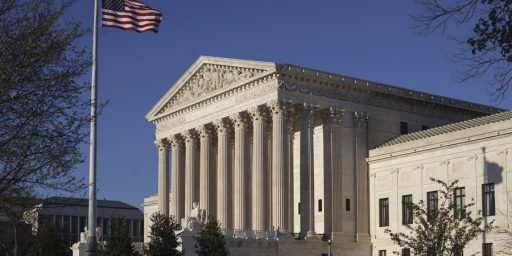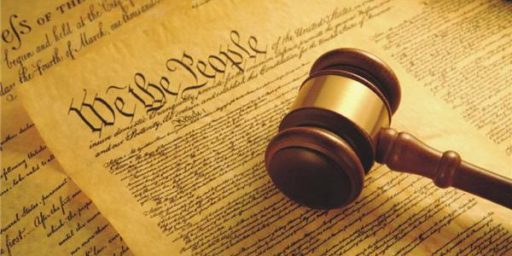DIVERSITY REDUX
I have an interesting discussion going with Kris in the comments section of this earlier post and have decided to revise and extend my remarks here for those who don’t read comments sections.
I summarized O’Connor’s decision this way:
States can discriminate on account of race as long as they are well intentioned and don’t use numbers to do it. Essentially, this is just a restatement of Powell’s murky lone opinion in Bakke but one that gives a stamp of approval to a specific program. Whereas Bakke struck down a program and told us what couldn’t be done, this case provides a blueprint for one that passes muster on the current Court.
Kris agrees but thinks it’s a good thing because it clarifies the situation. I agree that it is clearer than Bakke, but note that it not only doesn’t square with my view of the 14th Amendment but it also seems contrary to the last seventeen years of Court rulings on affirmative action.
Starting with the Wygant* case in 1986, the Supreme Court became increasingly suspicious of racial discrimination by states, even when designed to remedy past discrimination. The Croson case (1989) applied the strict scrutiny standard:
For the first time, affirmative action was judged as a “highly suspect tool.” The Supreme Court ruled that an “amorphous claim that there has been past discrimination in a particular industry cannot justify the use of an unyielding racial quota.” It maintained that affirmative action must be subject to “strict scrutiny” and is unconstitutional unless racial discrimination can be proven to be “widespread throughout a particular industry.” The Court maintained that “the purpose of strict scrutiny is to `smoke out’ illegitimate uses of race by assuring that the legislative body is pursuing a goal important enough to warrant use of a highly suspect tool. The test also ensures that the means chosen `fit’ this compelling goal so closely that there is little or no possibility that the motive for the classification was illegitimate racial prejudice or stereotype.”
Adarand (1995) extended this argument even further, saying
“Strict scrutiny” meant that affirmative action programs fulfilled a “compelling governmental interest,” and were “narrowly tailored” to fit the particular situation.
While O’Connor acknowledges these precedents in her opinion yesterday, she applies them in a bizarre manner:
Narrow tailoring does not require exhaustion of every conceivable race-neutral alternative or mandate that a university choose between maintaining a reputation for excellence or fulfilling a commitment to provide educational opportunities to members of all racial groups.
This is a political argument, not a constitutional one. Further, “narrow tailoring” traditionally applies to “remedying past discrimination” not “achieving diversity.” Still, one would think tht, in order to overcome the plain language of the Constitution, that all reasonable alternatives would have to be tried first.
The Court is satisfied that the Law School adequately considered the available alternatives.
The Court is also satisfied that, in the context of individualized consideration of the possible diversity contributions of each applicant, the Law School’s race-conscious admissions program does not unduly harm nonminority applicants.
This is rather absurd. The only “harm” at stake in these cases is not getting into the University of Michigan. The question is who should suffer this harm: the better qualified students or the less qualified students. The state is giving an unspecified “bonus” to black, Hispanic, and American Indian applicants and thus providing the most harm it can possibly inflict on the white, Asian, and other “nondeserving minority” applicants whose comparably superior performance has now been overtaken by the adding of this “bonus.”
Finally, race-conscious admissions policies must be limited in time. The Court takes the Law School at its word that it would like nothing better than to find a race-neutral admissions formula and will terminate its use of racial preferences as soon as practicable. The Court expects that 25 years from now, the use of racial preferences will no longer be necessary to further the interest approved today.
Aside from the fact, noted by Justice Thomas in his dissent, that the Constitution will presumably be unchanged 25 years from now, this passage is what as known as dictum. It is merely rhetoric spewed by O’Connor with no legal force. Whether the ability of states to discriminate against racial groups will expire in a quarter century depends on the composition of the Court then, not anything written here.
*For the sake of expediency, I’ll just cite the InfoPlease timeline. FindLaw and other sources will give you the text of the cases if you so desire.





